Mayra and I are standing beside the Quoyllur Sayana, the stone where the star stopped, in Calango. Because it is always a joy to escape from Lima traffic and walk in fresh air, and to give Amy a change, we are looking for stellar alignments. We have brought our star map apps and our compasses. Amy has a sketchbook and pencils.
This stone would seem a prime candidate as a heavenly reference. The name, the legend recorded almost 500 years ago, talks of falling stars, the skin of the star, the hair of the star.
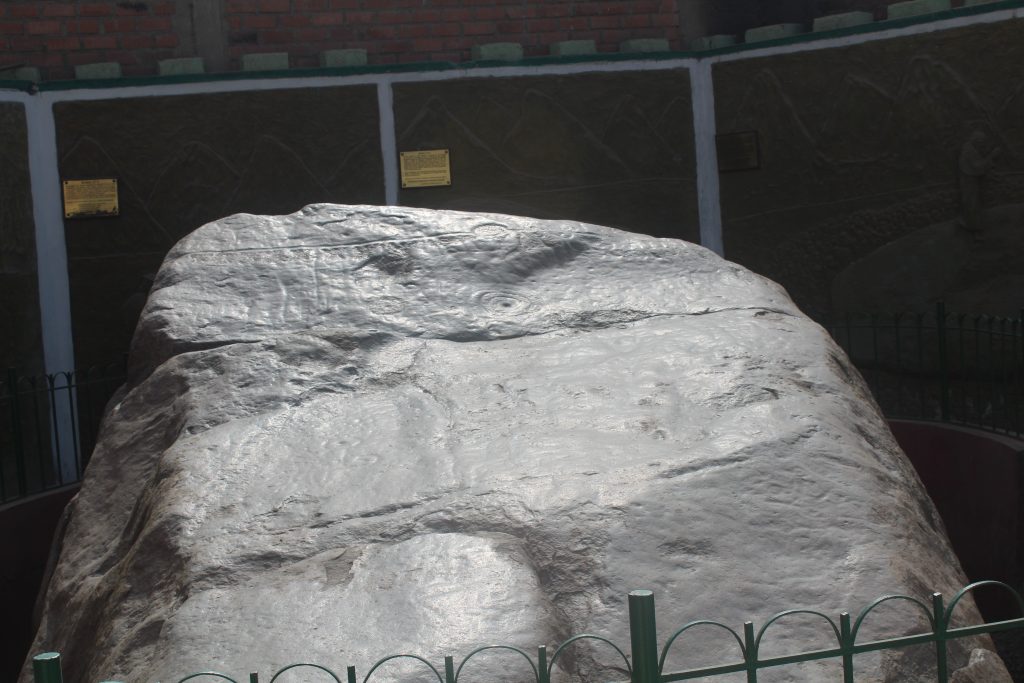
“It is so different to the stones upriver,” I tell Mayra. “Shiny-white, polished, so smooth.”
“Except where the Archbishop’s servant chiselled away the symbols.”
“There is an obvious change of texture there. It is as if there is some form of accretion on the rock, much thicker than the rock varnish, and very pale, that has been chipped away. But this rock is far from the river.”
“There are some common features such as the spiral,” says Mayra. “But it is all abstract lines, concentric circles, nothing figurative like llamas or birds.”
“The names in Quechua and perhaps Aymara refer to the stars, but the colonials who saw it were most impressed by the colour. “When the sun or moon shines on it, it seems to be made of silver,” Calancha wrote.”
“You wanted to find out what the name in Aymara was. LLumisca Lantacara. Did you make any progress?” She is laughing as she says it.
“Actually I did. Calancha’s translation was the skin or the clothing of the star, and llumi or llumpi, in some Aymara dialects, means a trailing garment. I found it in an Aymara dictionary compiled in 1612 by a Franciscan P Ludovico Bertonio, an Italian Jesuit working in Puno.”
“That’s promising! And this dictionary was waiting for you to discover it in a cramped and dingy bookshop in a back alley in Lima?”
“On the web. An amazing digital reprint site – photos of old books, page by page – called Biblioteca Digital Mundial.”
“Similar words beginning llumi, llumpi relate to shiny, clean, polished,” I continue, “which would be an appropriate description of this stone. Llumpaqa and llusq’a for example both mean polished or burnished. They may also refer to purification.”
“And this is a polished, shining stone.”
“Yes. But I have another interpretation. In Quechua, certainly round Huarochiri, words are composed of two parts. Pariacaca should be Paria Caca. Lunahuana is actually Luna Huana, and Huarochiri is Huaro Chiri. Most of the place names in the Huarochiri Manuscript are like that. Condor Coto, Sisi Caya, Pihcca Marca.”
“Interesting,” says Mayra.
“Even the towns and families, or ayllus, are structured like that. The District of Huaro Chiri had, and still has, two parts, Hanan and Lurin. That is where the name for the river Lurin derives.”
“Go on” Mayra says.
“It was a representation of a natural symmetry in the world, but also an anti-symmetry, a contrast. Two opposing parts make up a whole. Men and women. Highland and lowland. Sea and mountain.”
“Like the patterns in weavings,” she says.
“That’s right. But if we go eighty kilometres south to Yauyos, we find people who speak another language, related to Aymara. It is the last remaining home of a few hundred Jaqi speakers. The towns are Tupe, Cusi, Tinco, Alis, Vitis. A big change.”
“So what’s your point?”
Calancha heard Llumisca Lantacaura. He grouped the syllables like Quechua words. But perhaps what they said was “Llu Mis Cala Anta Caura. Cala or Qala in Aymara is stone, So Llumis Cala could be shining stone or trailing a dress on the stone or polishing the stone.”
“And what about the Anta Caura?”
“Anta is copper in Quechua and Aymara, and Cawra is a llama or an animal for sacrifice. Copper llama. I am still working on that.”
“I told you a year ago that you were wasting your time.”
“Thank you. I appreciate your support.”
We are standing at the lower end of the stone, which is like a giant double bed tilted from head to foot. We look up its inclined surface and towards horizontal grooves that run side to side where the pillows would be, with a now defaced band of markings between the grooves.
This would appear to give me a great measuring stick to measure positions across the sky. But the view beyond is towards the steep sloping side of the valley, or would be if the hideous enclosing wall were removed. Instead of seeing the sky outlined against the head of the stone I see a dark hillside.
“There is no archaeoastronomy here,” I exclaim.
“Try the side view, along that deep groove,” Mayra suggests.
Meanwhile Amy is standing in the shade, sketching the stone.
Standing at the head of the groove and looking upriver, I see the modern town of Calango and the valley beyond, broadening out into level fields. This would be a good spot to view the solstices, or the Pleiades’ first rising. But the incised line does not point towards those. It is directed 45 degrees east of north, a similar line to the U-shaped mounds of Lurin and the huacas of Maranga. Straight up the nearby hillside.
“There is nothing here,” I say, “at least nothing we can hope to understand now. Let’s head upriver.”
“Wait. There seems to be something on the top of that ridge,”says Mayra, pointing to the side of the valley, “a post or … a crucifix.”
“Calancha said they erected crucifixes here at sacred sites, because “the village in its entirety worships idols, and the priests of the huacas and the masters of witchcraft all live here.””
“So up there, on the ridge, there was once a sacred site, now destroyed and topped off with a wooden crucifix?”
“That sounds about right to me.”
I raise my compass and take a bearing on the crucifix.
“60 degrees, more or less. Very close to the Pleiades rising, or the solstice. Interesting. You can imagine some people might watch the rising from this spot, and others would climb the mountain at the appropriate time of year. I would love to see what’s up there. But I don’t think we can walk up that hill today with Amy. I can check it out later on Google Earth. Let’s just head up the valley.”
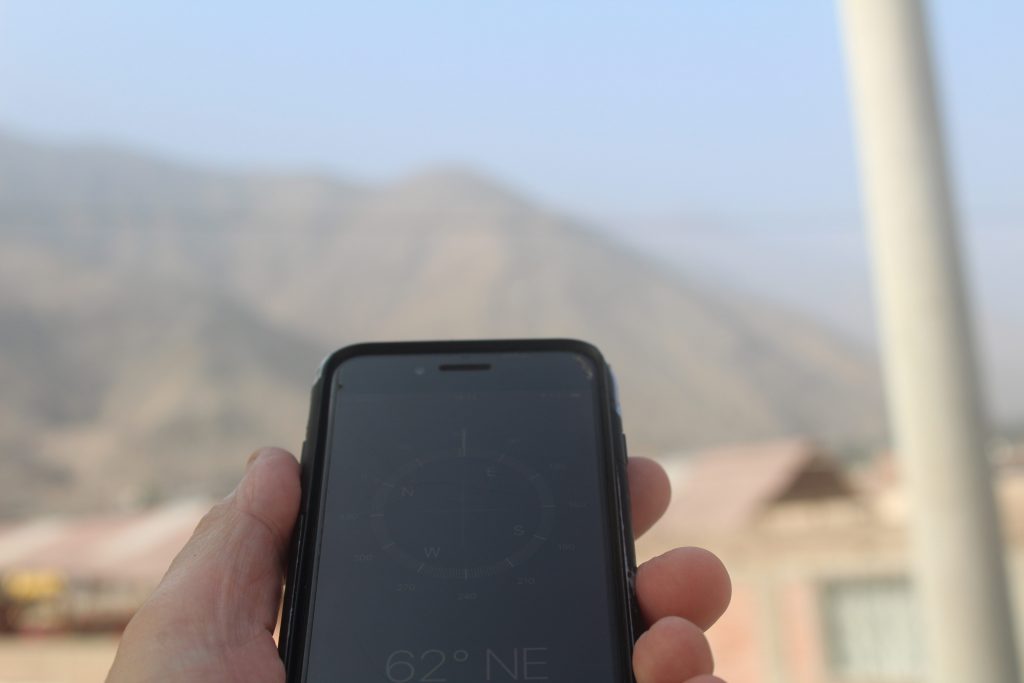
*********************************************************
It is good to walk by the river again, smell the apple blossom and hear the gurgling of water in the irrigation channels that threads through the orchards. Amy was walking as if under a black cloud at the start of the day, but the sunlight and breeze seems to be working its magic.
The hills tower on either side, rising to 2000 or 3000 metres, even this close to the coast. I know that there are paths up there, and corrals, and collections of buildings round rocky outcrops. There is a human landscape, preserved in time from a thousand years ago.
After a couple of hours walking up the valley we reach the stones. It is late August, and the river is still low. We wade across, the water up to our knees. The floods at the start of the year have created a deep blue-green pool below a great rock that also, I see now, has some llamas and serpents engraved on its rough-hewn surface.

“There are seven major rocks,” I explain to Amy, “and a dozen more that have some images. I want to see if there is anything that could relate to the position of the sun or the night sky – pointers, images of stars, stones casting shadows. Or, you could just walk round and sketch anything interesting.”
Amy sidles off, no doubt glad to be left alone for a while.
“With thousands of images on the rocks, it should be easy to find some imagined reference to the night skies in the engravings here,” says Mayra.
“I find that there is so much to see, I have to focus on one issue for each visit, ” I reply. “I spent one trip looking at llamas with Sayana, and many weekends looking at photos from our first visit and seeking to interpret the tupus and tumis.”
“And now it is suns and stars. OK, lets go!”
At the southern end is the largest rock, three metres wide and six metres long. Its upper surface is ravaged, with areas cleaved off by time and weather. There are so many images here, layer upon layer. Fish, birds, figures holding staffs. The dominant image is the giant tumi which I have seen so many times. But now, for the first time, I see it as a pointer.
“Look Mayra!” I cry, “can you see? These tumis are direction indicators! The big one in the centre, and others to the left and right!”
I check the alignment with the compass.
“But it is pointing on a bearing of 100 degrees,” I say, disappointed.
“They could be pointing at the heavens, or they could just be pointing across the river,” she says sarcastically. “You could imagine all the tumis are arrows, but most of them are pointing at the ground.”
We move on. There are rayed circles, spoked wheels and crosses – symbols which could represent stars, suns or moons – on many rocks, on almost every rock. The majority are drawn close to the peak of the rock, or on a flat surface facing skywards. Over twenty are drawn on the flat upper surface of the most northerly rock, facing skyward. In three places there are groups of seven dots, in a circle. But it is all too vague.
“What do you think you might find,” asks Mayra, “a star chart?”
I tell her about Chankillo, intihuatanas, the Moche lunar deity. She knows all this, and I know she knows. I am just going over it in my mind.
“I am thinking that if I stand here with a perspective on the heavens, I might see something new” I tell her. “The Pleiades rising will come just over the shoulder of the hill there,” I say, pointing upstream and to the right bank. The sun rises there,” I point to the right, “and sets there,” to the left.
“And at the solstice the sun will be in that direction, and then it will gradually move south, downriver, until it passes overhead just here.”
And then Amy, who has been wandering with impressive intent from stone to stone, calls out.
“Come and look at this!”
She is standing before a panel covered in images, many of them overlapping, of birds, spirals, llamas and plants.
“This looks to me like some kind of sundial,” she says, pointing to a shadow cast low down on the rock.
The panel is at a slight angle to the vertical. The sun now, in late June, is shining from above the panel. An outcrop of rock on the right of the panel casts a long shadow. The shadow falls on the rock surface below, which is marked with a simple ellipse, and a line of eighteen dots.
“It’s a gnomon!” I exclaim. “The shadow here will measure the position of the sun for a month or two around the June solstice. Amy, it is beautiful!”
I have found a gnomon!” Amy smiles. “That’s great!”
“What’s a gnomon?” asks Mayra.
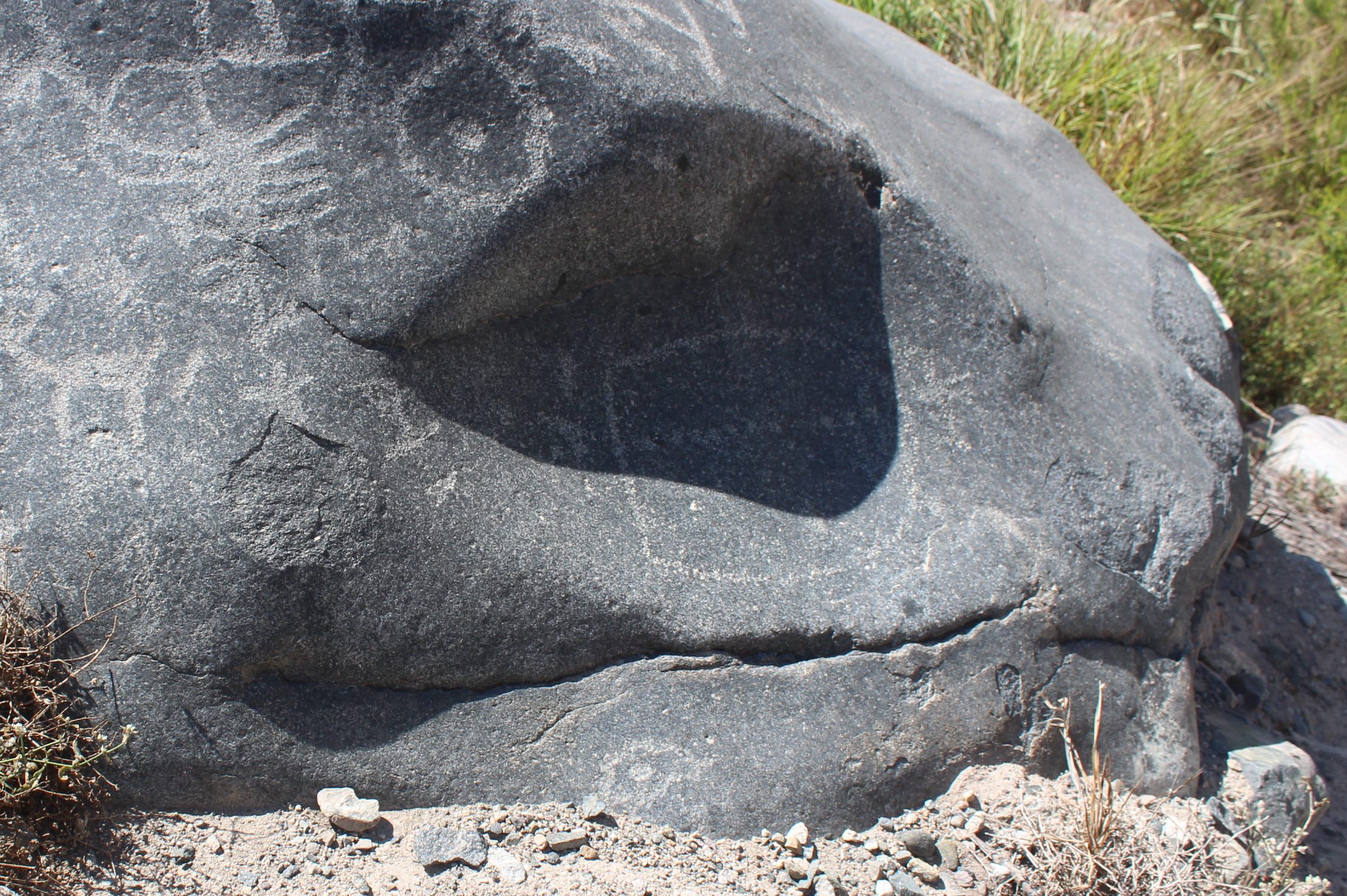
“It is the part of the sundial that casts a shadow. The shadow moves across the dots from left to right during the day. But the variation around the solstice is more powerful. Here we are on June 30, and we have a long shadow. Nine days ago, at the solstice, the sun was at its most northern position. The shadow probably approached the lower edge of the ellipse at that time. Now the shadow is shortening, as the sun moves back south through July. By August, and for the rest of the year through to April there will be no shadow.”
“So it is a specific marker for the date, a month or two either side of the solstice?”
“The movement of the shadow between the upper and lower edge of the ellipse would take place over a month, so it would change by almost a centimetre every day,” I suggest. “The width of the shadow, at midday for example, could be measured with the 18 dots. Someone could use this to predict the solstice to within a day or two. They could probably also predict the date when the Pleiades re-appears over the shoulder of the hillside upriver.”
“There is another shadow,” says Amy, ” that falls across the spiral.”
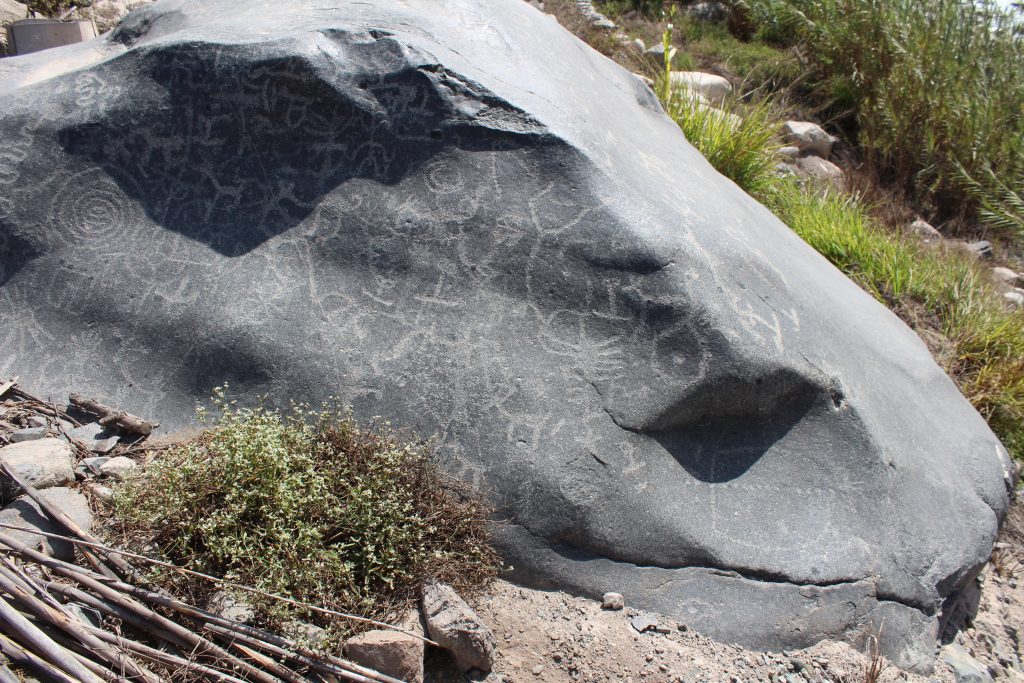
“That explains something I was curious about, ” I tell Amy. “Every major rock here has a spiral, usually in the centre, and the spirals usually have three turns. But this one is much bigger, with five or six turns. Because it is a marker for the shadow, perhaps?”
“So it is measuring the length of the shadow, which will reach to the centre or the far side at a particular date?”
“It would not be a surprise,” I explain. “The Huarochiri Manuscript tells us that the time of annual festivals was determined in just such a manner. The yanca official determines the date of the festival. “This man observes the course of the sun from a wall constructed with perfect alignment. When the rays of the sun touch this calibrated wall, he says “now we must go” or…”tomorrow is the time.”“
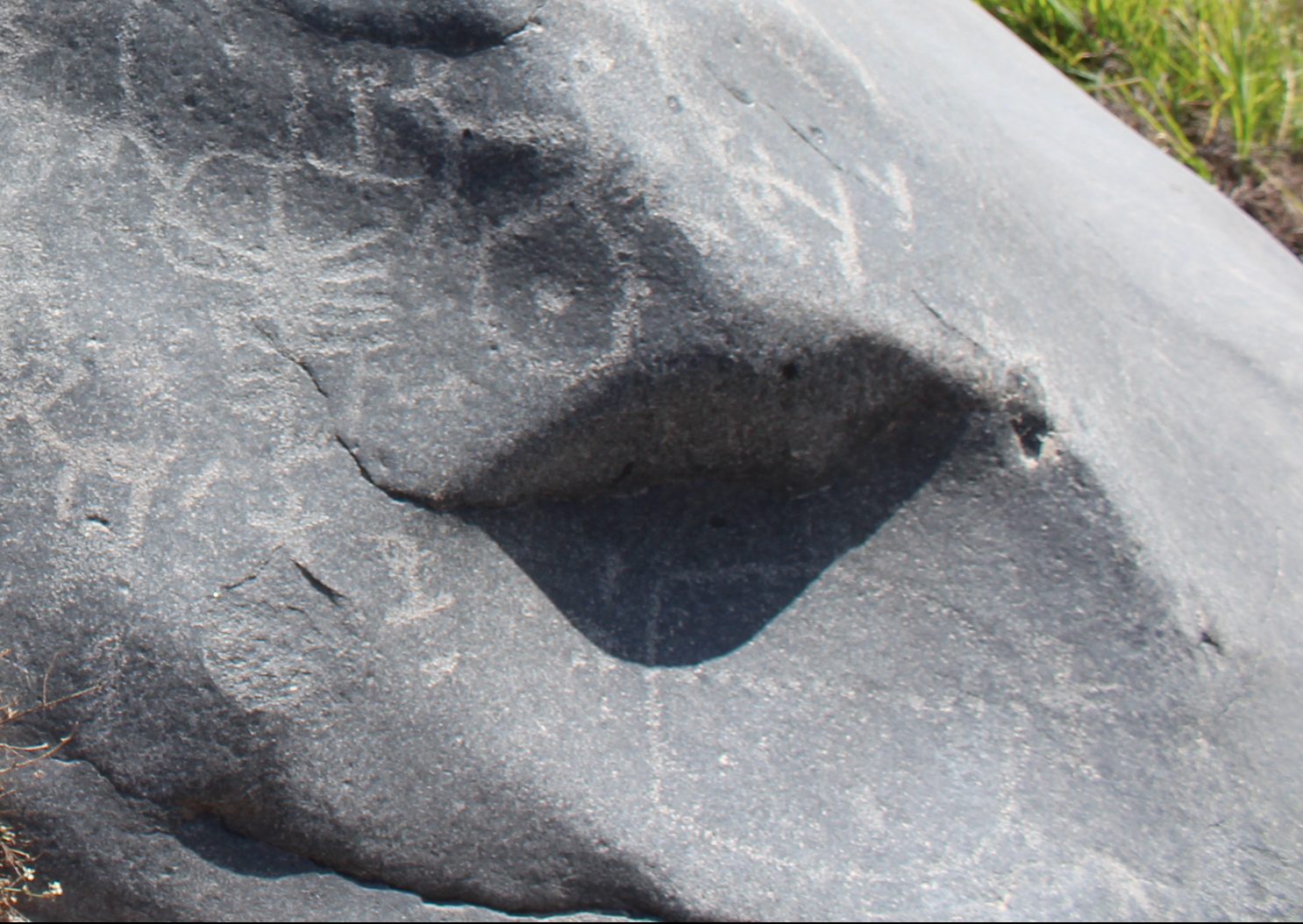
“In Huarochiri, annual festivals described in the Manuscript are linked to farming seasons and weather, measured by celestial markers, and celebrated with music, dancing and drunkenness,” I continue. “This marker predicts the date of solstice or of Pleiades rising, which suggests the stones were part of a seasonal festival, or were used by the ritual managers who planned such a festival.”
